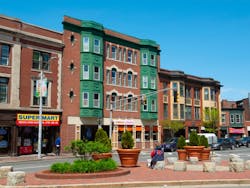As energy democracy and social justice increasingly drive energy planning, Chelsea, Massachusetts hopes to become a model for how it’s done by developing a ‘microgrid without borders.’
Community and climate activists, city officials and energy veterans have come together to develop an unusual microgrid designed to incrementally add buildings through virtual, not physical, connections.
David Dayton, CEO of Clean Energy Solutions and a consultant to the project, describes it as a “neighborhood led, municipally sponsored microgrid without borders.” The buildings are connected contractually and through a cloud-based platform, which allows a central controller to aggregate their energy storage, solar power and load management into a virtual power plant.
Located near Boston, Chelsea is a small industrial city, just 2.2 square miles, and one of the state’s most population dense. The city has many reasons for pursuing the microgrid, but it was an event nearly 1,700 miles away that became a driving force for action: Hurricane Maria in Puerto Rico. The storm decimated most of the island’s grid in 2017, creating the largest blackout in US history. For Chelsea’s large Puerto Rican population, the hardship felt close to home.
“After Hurricane Maria people were waiting for the state to come in and bail them out and it never happened,” said Fidel Maltez, commissioner of the Chelsea Department of Public Works, in an interview with Microgrid Knowledge. “People have to come together on their own and really figure out resiliency.”
Powerful city/community alliance
And that’s how it’s happening in the city. The team behind the project includes GreenRoots, a community-based environmental justice organization and Climable, a climate organization that lists as one of its primary goals the development of community microgrids; and the city government.
In working on the microgrid, GreenRoots represents the community and approves all design and development decisions, while Climable chairs the technical team and communicates among all stakeholders.
“The alliance between that nonprofit and the city is a powerful tool for developing a microgrid that is rooted in this concept of energy as a public good,” said Dayton.
The project recently won a $200,000 grant through the state’s Green Communities program and the team is in early discussions with developers. The city plans to be the host and owner of the microgrid assets. And while it’s financing plan isn’t established yet, the team hopes the city will self-fund the project, possibly through a bond or cash reserves. “The goal is to keep this as a public asset,” said Maltez.
Learn more about the Chelsea microgrid in a special session at Microgrid Global 2020, “Energy Resilience for All: Access, Equity and Social Justice.” Registration is free.
City hall, which includes a 911 emergency call center, will be the first building connected to the microgrid, which the team hopes to complete in 12-24 months. Banks of batteries will provide both electric reliability and peak shaving. The plan also calls for solar, if it can be installed on the historic building, and generators that use biodiesel or bio-derived methane. The microgrid will allow the city to decommission diesel backup generators it now uses.
Savings achieved by the microgrid will exceed repayment costs for installation. “So that makes it commercially sustainable,” Dayton said. The microgrid will earn revenue and achieve savings a variety of ways — through incentives and by providing grid services and leveraging energy storage.
Chelsea also has applied for funding from the Metropolitan Area Planning Council, a regional planning agency, to add the police station, where a solar installation is planned.
Other public and private buildings will be added later, which can be done easily, Dayton said, because of its “microgrids without borders” approach.
“We don’t have to be limited to buildings that are connected together with wires. We can add buildings anywhere in the city. So you can pick up low-income housing and nonprofits and health centers, city buildings, wherever they are,” Dayton said.
Uniqueness of the Chelsea microgrid
A combination of factors make the project unique, the team said. First, it’s “centered around community and I think that’s rare,” said Jen Stevenson Zepeda, associate director at Climable.
Added Dayton: “There are a lot of microgrids in the world, but on campuses, industrial complexes, military bases…They’re all wired together. They’re focused on commercial interest and not community interest, and they don’t allow growth building by building as ours does. We don’t have any models anywhere that we can find of a neighborhood led municipally sponsored microgrid without borders. That’s what we hope to demonstrate and replicate.”
Track news about the community microgrids. Subscribe to the free Microgrid Knowledge newsletter.







